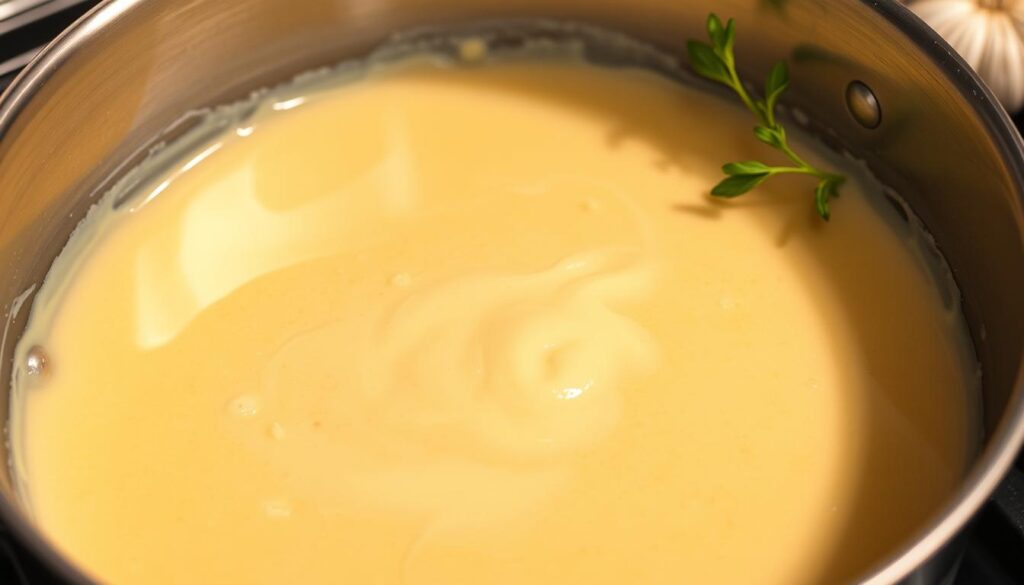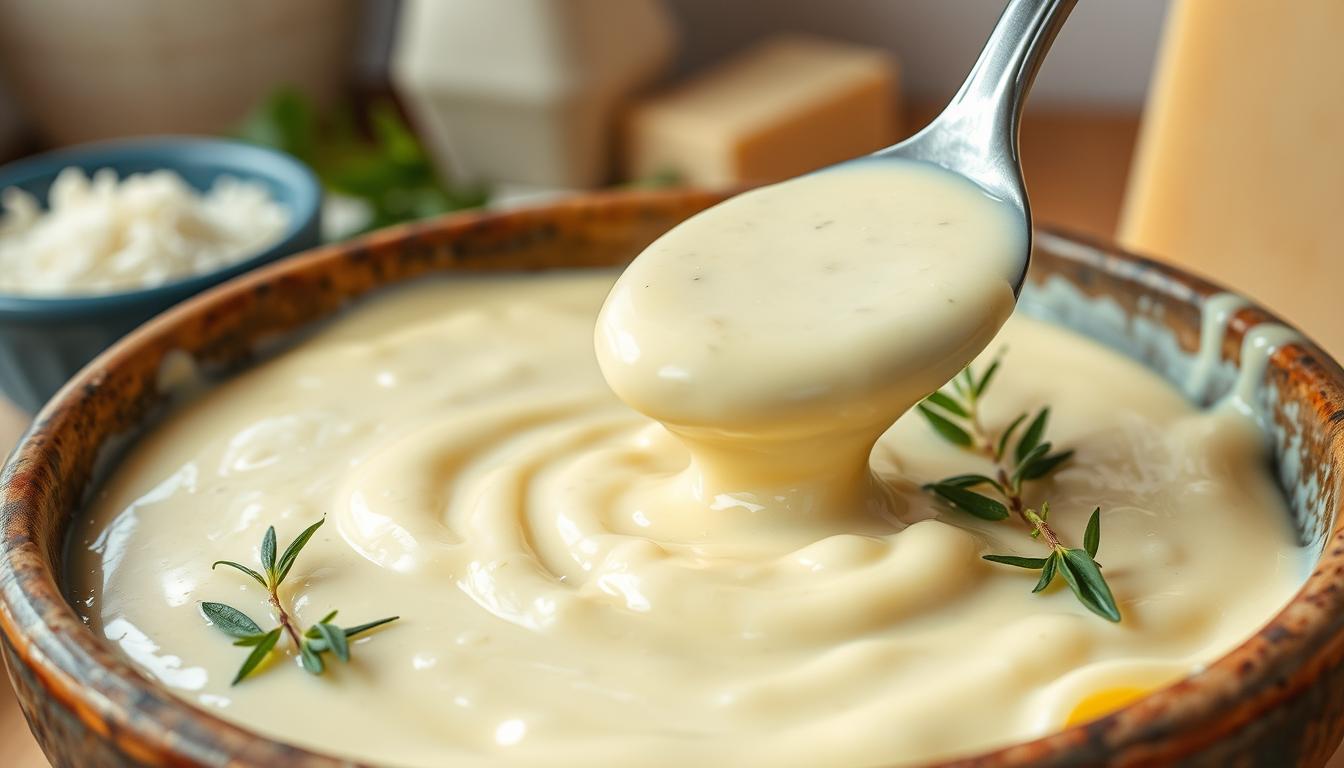Making a velvety, thick Alfredo sauce at home is a big win for pasta lovers. This dish is famous for its rich, creamy texture that wraps each noodle in flavor. But, many home cooks often wonder: What is the secret to thick Alfredo sauce as good as a restaurant’s?
In this guide, we’ll share the key techniques and ingredients that chefs use to make a thick, indulgent Alfredo sauce. Understanding what is the secret to thick Alfredo sauce will take your pasta dishes to the next level, ensuring each bite is packed with flavor and the perfect creamy consistency.
Key Takeaways
- Understand the importance of a roux-based sauce for achieving a thick, creamy Alfredo
- Learn how to select the best quality butter and Parmesan cheese for maximum flavor
- Discover temperature control and continuous stirring techniques to prevent curdling
- Explore flavor enhancement options and serving suggestions for a restaurant-style experience
- Troubleshoot common issues like thinning consistency and prevent common pitfalls
The Essence of Alfredo Sauce
The history of Alfredo sauce goes back to the early 1900s in Italy. It’s made from simple ingredients: butter, Parmesan cheese, and cream.
History and Origin
Italian chef Alfredo di Lelio created Alfredo sauce in Rome in the 1920s. He made it for his pregnant wife, who wanted something rich and creamy. The sauce quickly became famous, loved by people all over the world.
Traditional Ingredients
The traditional Alfredo recipe uses just a few ingredients. These are:
- Butter: High-quality, unsalted butter gives the sauce a rich feel.
- Parmesan cheese: Freshly grated, it adds a savory taste and thickens the sauce.
- Cream: Heavy cream or half-and-half makes the sauce creamy and smooth.
Knowing the history of Alfredo sauce and its classic Alfredo ingredients is key to making the perfect sauce.

“The essence of Alfredo sauce lies in its simplicity – just a few high-quality ingredients coming together to create something truly special.”
Mastering the Roux
The secret to a velvety Alfredo sauce is a good roux. A roux is a mix of flour and fat, thickening the sauce. Making the roux right is key to the sauce’s perfect consistency.
To start, melt butter or use olive oil in a pan over medium heat. When the fat is hot, add an equal amount of flour slowly. Stir constantly until it smells nutty and turns light golden, about 5-7 minutes.
It’s important to cook the flour just right. Too dark and it tastes heavy, too light and it’s not thick enough. This balance makes the sauce creamy without tasting floury.
After the roux is done, add the milk or cream slowly. Whisk well to avoid lumps. Keep stirring until the sauce is thick and creamy. This step is crucial for a rich Alfredo sauce.

“The secret to a perfect Alfredo sauce is all in the roux. Take the time to get it just right, and your sauce will be silky smooth and delicious.”
The Importance of Quality Ingredients
Creating the perfect Alfredo sauce starts with top-notch ingredients. The best butter for Alfredo sauce is usually unsalted European-style butter. It adds a creamy texture and a subtle flavor that enhances the sauce.
Selecting the Right Butter
While regular unsalted butter works, European-style butter makes a big difference. It has more fat, making the sauce smoother and richer. This ensures the Alfredo sauce sticks well to pasta.
Choosing the Perfect Parmesan Cheese
The types of Parmesan cheese for Alfredo are crucial. Freshly grated, high-quality Parmesan, like Parmigiano-Reggiano, brings a rich flavor. It also adds a creamy, nutty taste to the sauce. Stay away from pre-grated Parmesan, as it can ruin the sauce’s smoothness.
| Ingredient | Best Options |
|---|---|
| Butter | Unsalted European-style butter |
| Parmesan Cheese | Freshly grated Parmigiano-Reggiano |
Choosing the best butter for Alfredo sauce and the perfect Parmesan cheese takes your Alfredo sauce to the next level. It becomes creamy, rich, and full of flavor.
Cooking Techniques for Creamy Perfection
To make the perfect Alfredo sauce, you need to know some cooking tricks. Keeping the right temperature and stirring the sauce constantly are key. These steps help the sauce mix well and get the right thickness.
Temperature Control
How hot you cook the Alfredo sauce matters a lot. Heat it slowly over medium heat, but don’t let it boil. Boiling can make the sauce curdle and lose its smooth texture. Try to keep the heat between 160°F and 180°F for the best results.
Continuous Stirring
Stirring the Alfredo sauce gently but constantly is very important. This keeps the sauce smooth and prevents lumps. Use a wooden spoon or whisk to stir, making sure to get the bottom and sides of the pan. This helps avoid a skin or film forming on the sauce.
| Technique | Description |
|---|---|
| Temperature Control | Maintain a temperature between 160°F and 180°F to prevent curdling and ensure a smooth, creamy texture. |
| Continuous Stirring | Stir the sauce continuously with a wooden spoon or whisk, scraping the bottom and sides of the pan to prevent the formation of a skin or film. |
Learning these techniques will help you make a thick, creamy, and irresistible Alfredo sauce every time.
“The key to a perfect Alfredo sauce is patience and attention to detail. Slow and steady stirring, along with precise temperature control, are the secrets to achieving that velvety smooth texture.”
What is the secret to thick Alfredo sauce?
The secret to thick Alfredo sauce is mastering a few key techniques and using top-notch ingredients. Understanding the roux, choosing the right butter and cheese, and cooking properly are key. This way, home cooks can make thick Alfredo sauce just like restaurants.
One main tip for how to make Alfredo sauce thicker is to focus on the roux. The roux, made from butter and flour, thickens the sauce. It’s important to cook the roux until it’s golden before adding cream and cheese.
- Use high-quality butter and Parmesan cheese for maximum flavor and creaminess.
- Gradually add the Parmesan cheese to the roux, allowing it to melt and incorporate fully before adding more.
- Reduce the heavy cream further by simmering it for a few extra minutes to evaporate some of the liquid.
- Toss the cooked pasta with a bit of flour before adding the Alfredo sauce for a thicker, more cohesive texture.
Also, tips for thick Alfredo sauce include keeping the cooking temperature steady and stirring constantly. This prevents curdling or separation. By using these simple techniques, home cooks can impress their guests with a delicious, thick Alfredo sauce.
“The key to a creamy, thick Alfredo sauce is all in the method. By paying attention to the roux and using high-quality ingredients, you can create a sauce that’s truly indulgent.”
Troubleshooting Common Issues
Even the most skilled cooks face challenges with Alfredo sauce. Knowing how to stop curdling and adjust the sauce’s consistency is key. This helps home cooks get the perfect creamy texture every time.
Preventing Curdling
Alfredo sauce often faces the issue of curdling. This happens when the sauce gets too hot or the temperature changes suddenly. To avoid curdling, keep the heat low and stir the sauce constantly while cooking.
- Don’t let the sauce boil, as high heat can cause the cheese to separate.
- Add cheese slowly, letting it melt fully before adding more.
- If curdling happens, remove the sauce from heat and whisk hard to mix it back together.
Adjusting Consistency
Getting the right consistency in Alfredo sauce can be tricky. If it’s too thin, it won’t coat the pasta well. If it’s too thick, it can be gloopy.
- To make a thick sauce thinner, add warm milk or cream slowly, whisking until it’s right.
- To thicken a thin sauce, simmer it gently, stirring often, until it thickens.
- Adding a bit of cornstarch or flour mixed with water can thicken it, but be careful not to add too much.
By understanding these common Alfredo sauce problems and how to fix them, you’ll make a smooth, creamy sauce every time.
Flavor Enhancements and Variations
Classic Alfredo sauce is loved by many, but you can make it even better. Adding herbs, garlic, or white wine can change its taste. It’s a chance to try new things and make it your own.
Adding fresh herbs like parsley, basil, or thyme can make the sauce taste amazing. Roasted garlic adds a deep, sweet flavor that goes well with Parmesan.
For a more complex taste, try adding a splash of white wine. It adds a bit of acidity and makes the sauce more balanced. This balances out the richness of butter and cheese.
There are many ways to make alfredo sauce variations. Here are a few ideas:
- Sautéed mushrooms for a rich, earthy flavor
- Sun-dried tomatoes for a sweet and tangy twist
- Crumbled bacon or prosciutto for a salty kick
- Spinach or other greens for extra nutrition
With so many options, you can make flavor ideas for alfredo that fit your taste. Try different add-ins for alfredo sauce to find your favorite.
“The beauty of Alfredo sauce lies in its versatility. With a few simple additions, you can transform a classic dish into something truly unique and extraordinary.”
Serving and Pairing Suggestions
Alfredo sauce is a rich and creamy delight that can make many dishes better. It’s great with pasta and wine. Let’s explore some pairing ideas.
Complementary Dishes
Alfredo sauce goes well with long, thick pasta. This helps the sauce stick to the pasta. Here are some top picks:
- Fettuccine – The classic choice for Alfredo sauce, fettuccine’s wide ribbons provide the perfect canvas for the creamy sauce.
- Pappardelle – These broad, flat noodles are ideal for scooping up and showcasing the luxurious Alfredo sauce.
- Linguine – The long, thin strands of linguine work beautifully in capturing and distributing the rich Alfredo sauce.
Alfredo sauce also pairs well with grilled or roasted proteins. Chicken, shrimp, or salmon are all great choices. The sauce adds a savory touch to these dishes.
Wine Pairings
For wine pairing for alfredo, choose wines that match its richness. Here are some good options:
| Wine Varietal | Flavor Profile | Why it Works |
|---|---|---|
| Chardonnay | Oaked, full-bodied | The oak aging and creamy texture of Chardonnay echo the Alfredo sauce, creating a seamless pairing. |
| Sauvignon Blanc | Crisp, refreshing | The bright acidity of Sauvignon Blanc helps to cut through the richness of the Alfredo sauce, providing a refreshing contrast. |
| Pinot Grigio | Light, dry | The delicate flavors and clean finish of Pinot Grigio complement the what to serve with alfredo sauce without overpowering it. |
Choosing the right pasta and wine can elevate your Alfredo sauce experience. It’s a way to enjoy this Italian-American classic to the fullest.
Conclusion
Learning to make thick and creamy Alfredo sauce at home is a rewarding journey. It can take your pasta dishes to new levels. By understanding the summary of thick alfredo sauce, you can make it just like the restaurants do.
This article has given you a recap of alfredo sauce tips. You now know how to make the roux, choose the best butter and Parmesan cheese. These steps will help you make a sauce that is thick, smooth, and full of flavor. With practice, you’ll make Alfredo sauce that will wow everyone.
As you think about homemade Alfredo, remember the joy of cooking is in the journey. Don’t be afraid to try new things and make the sauce your own. This way, you’ll not only get better at cooking but also create your own special version of this classic dish.
